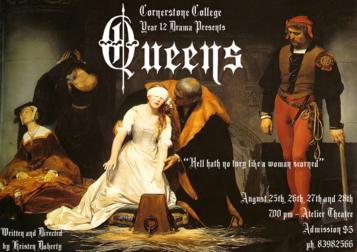
Before I carry on with my series of posts looking into Anne Boleyn’s relationships with other people at the Tudor court, I just wanted to share with you the photos of Kristen Doherty’s play “Queens: Hell Hath no Fury Like a Woman Scorned” which she did with her Year 12 drama pupils in Australia.
In “Queens”, the audience meets King Henry VIII chained up in Purgatory having to relive the treatment that he dished out to the women in his life, and women who were affected by his behaviour and actions – his six wives, Lady Jane Grey, Mary I and Elizabeth I. The women tell and act out their story to the King in the hope that he will be able to understand what he did to them and empathise with them.
Will he learn from their re-enactments? Will his eyes be opened to the monster and tyrant that he became? Will he work his way out of Purgatory? This is what Kristen’s play is about.
Many of you were interested in Kristen’s play, when I mentioned it on Facebook, and so you’ll be glad to know that it was a roaring success and I’ve already heard from her Anne Boleyn actress who is now using The Anne Boleyn Files to find out as much as possible about Anne Boleyn – she’s now addicted to Tudor history! I know from reading Kristen’s script (couldn’t quite justify travelling to Australia to see it!) that Kristen based her play on real history and sought to be as accurate as possible. This means that her pupils and her audiences learned the real story of Anne Boleyn and the other Queens, and their relationship with Henry VIII. This is fantastic in a world where myths and lies are still being proliferated – thanks Kristen!
Enjoy this slideshow of photos from “Queens”:-
[slideshow id=89 w=500 h=400]
But, Kristen is not the only one to be inspired by Anne Boleyn’s story, many other people have emailed me to say how learning Anne Boleyn’s story has affected their lives and how they’re being inspired by her. Obviously I was inspired to put this site together and on this site you will also find poems on the life of Anne Boleyn by Esther Hyams – see www.theanneboleynfiles.com/resources/anne-boleyn-words/poetry-about-anne/.
Anne Boleyn Files visitor Kimberley is writing a novel which she describes as “paranormal historical fiction” which interweaves the story of a modern day female auction house owner with the story of Anne Boleyn. Kimberley’s first two chapters are on her blog and it really does look like this book is going to be a fantastic read – well done, Kimberley! Click here to read Chapter 1 and click here for Chapter 2.
I know there are also other AB Files visitors who are being creative and writing novels, plays and poems, and if Anne Boleyn has inspired you, please take the time to comment below and let us know about it.